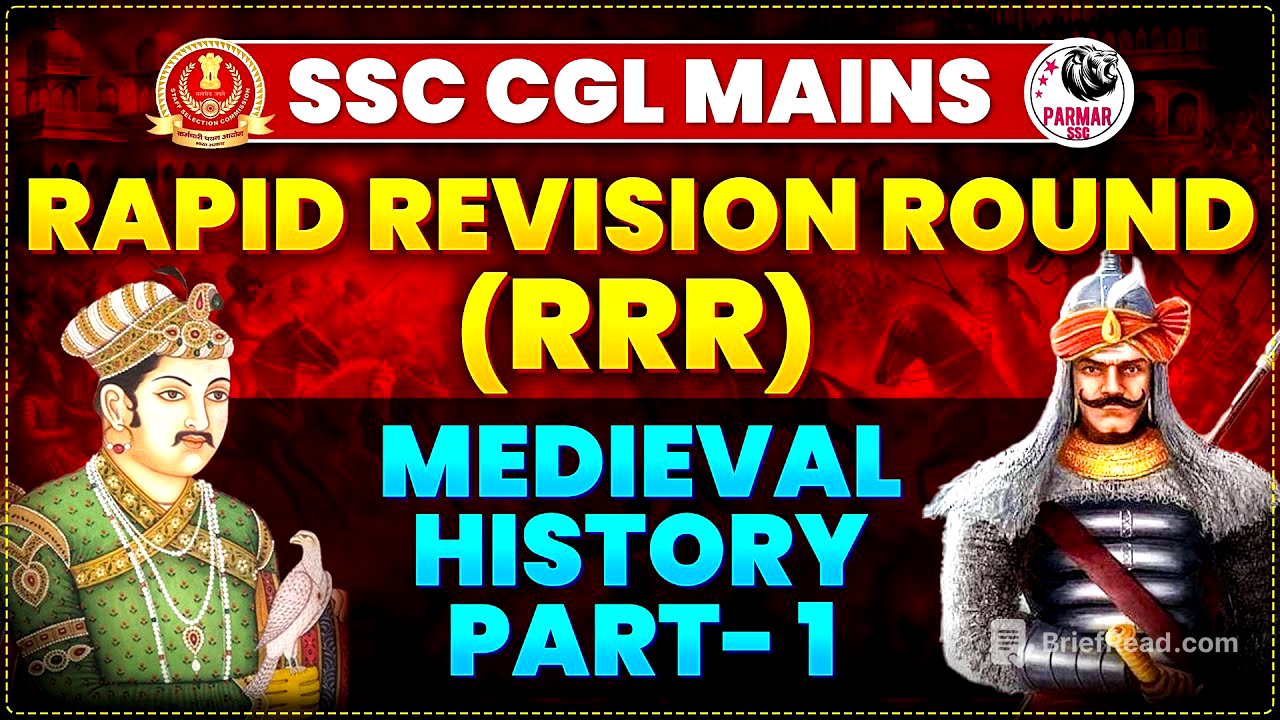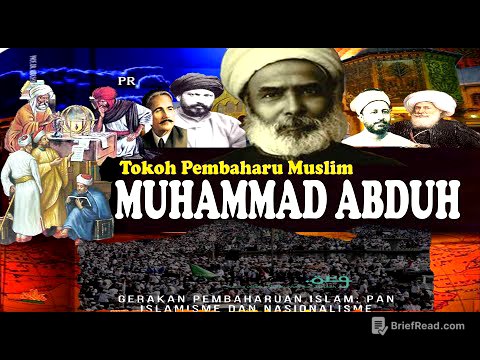TLDR;
This lecture covers medieval Indian history, focusing on the Chola dynasty and the Delhi Sultanate. It addresses corrections from a previous lecture, then discusses the Cholas, distinguishing between Early and Later Cholas, their emblems, port cities, and significant literary works from the Sangam period. The lecture then moves to the Delhi Sultanate, detailing the Muslim invasions, the Slave Dynasty, the Khilji Dynasty, the Tughlaq Dynasty, the Sayyid Dynasty, and the Lodhi Dynasty, including key rulers, their policies, and architectural contributions.
- Corrections from previous lecture about dates and names.
- Overview of Chola dynasty, Sangam period and their literature.
- Delhi Sultanate and its various dynasties with key rulers and their policies.
Corrections and Introduction [0:00]
The lecture begins with corrections to a previous discussion on ancient history, specifically clarifying that the edicts of Ashoka were deciphered in 1837 and published in 1838 by James Prinsep. There was also a correction regarding Nagar Shresthi and clarifying that Hari Sen did not hold that post. The lecture then transitions to the main topic: medieval history, starting with the Chola dynasty and the Tripartite Struggle.
Chola Dynasty: Early and Later Cholas [1:11]
The lecture distinguishes between Early and Later Cholas. Early Cholas existed around the 3rd century BC to the 3rd century AD, during the Sangam period, alongside the Cheras (Kerala Putta) and Pandyas. The emblems of these dynasties were bow and arrow for Cheras, fish for Pandyas, and tiger for Cholas. Their port cities were Muzari and Todi for Cheras, Kolk for Pandyas, and Puhar or Kaveripatnam for Cholas. The second Sangam took place in Kapatpuram, and Tolka Piyar composed Tolka PM, considered the oldest Tamil literature. The lecture also mentions Sheela Padakram, an epic written during the Sangam age by Dangor Gal, depicting the love story of Kovalan, Kanagar, and Madhavi, and Mani Mein Galai, a book written about their daughter by Tan. Later Cholas emerged around the 8th century AD, with Karai Kal defeating the Mut Yars in the Cauvery delta and building Tanjore.
Key Rulers of the Chola Dynasty [6:04]
Raja Raja One, a prominent ruler of the Chola dynasty, conquered the Maldives and maintained good relations with the Sri Wizd Empire of Indonesia, ruled by the Shailendra Dynasty. His reign lasted from 985 to 104 AD. His son, Rajendra Chola, conquered Sri Lanka (Ceylon) and defeated the Shailendra Dynasty, completing constructions in the Sri Vijay Empire. Rajendra Chola was a contemporary of Mahmud Mu Ghaznavi. The temples built by the Cholas, known as the Great Living Chola Architecture, include the Brihadeshwara Temple.
Chola Architecture and Land Donations [7:36]
The lecture details the Brihadeshwara temples in Tamil Nadu, one built by Raja Raja Van (Raj Rajeshwar Temple in Thanjavur) and another by Rajendra Chola Van in Gangai Konda Cholapuram. The Rawate Shivara temple was built by Raja Raja the Second. All these temples are in the Dravidian style of architecture. The lecture explains the differences between Nagar (North Indian) and Dravidian (South Indian) styles, noting common elements like Garbha Graha and Mandap, but differing in Shikhar (North) and Vimana (South), and the presence of Gopurams in Dravidian temples. Land donations by the Cholas were categorized as Shaal Bhog (for schools), Brahmadeya (for Brahmins), Devdan (for temples), Palli Chandam (for Jain temples), and Velan Vagai (for non-Brahmins). The lecture also identifies Vellalars as rich landowners, Uzavurs as common tenants, and CRs as manual laborers.
Delhi Sultanate: Early Muslim Invasions [13:37]
The lecture transitions to the Delhi Sultanate, starting with the Muslim invasions in the 11th century AD. The first Islamic invasion occurred in 712 AD when Arab ruler Mohammed bin Qasim attacked the Sindh province. Mahmud Ghaznavi, a contemporary of Rajendra Chola I, attacked India 17 times, primarily for loot. His 16th attack was on Somnath in 1025 AD. Alberuni, who accompanied Ghaznavi, wrote "Tahqiq Hind," and Firdausi wrote "Shah Nama" during this period.
Delhi Sultanate: Ghori's Invasions and Slave Dynasty [15:22]
Mohammed Ghori attacked India between 1175 and 1266 AD. In 1178, he attacked Gujarat but was defeated by Queen Naki Devi of the Solanki dynasty. In 1191, he clashed with Prithviraj Chauhan (Prithviraj Third) in Tarain and was defeated. However, in 1192, Ghori defeated Prithviraj Chauhan. Chandra Badai wrote "Prithviraj Raso." In 1194, Ghori defeated Jaichand of Garhwal in the Battle of Chandawar. After Ghori's death, his slaves, including Qutubuddin Aibak, ruled various regions. Qutubuddin Aibak, who helped Mohammad Ghori in the second battle of Tarain, laid the foundation of the Delhi Sultanate in 1206 AD. The first dynasty was the Slave Dynasty or Mamlu Dynasty.
Slave Dynasty: Qutubuddin Aibak and Iltutmish [17:46]
Qutubuddin Aibak, who ruled from 1206 to 1210 AD, started the construction of the Qutub Minar and built the Aadhai Din ka Jhopra in Ajmer and the Quwatul Islam. He was known as Lakh Baksh. He died while playing Chaugan (polo). Iltutmish, Aibak's son-in-law and slave, shifted the capital from Lahore to Delhi. He completed the fifth story of Qutub Minar, which has a height of 72.5 meters.
Slave Dynasty: Iltutmish's Reforms and Razia Sultan [19:25]
Iltutmish introduced the silver tanka and copper jetal coins, the Chahalgani system (Turkane Chahalgani - a group of 40 slaves), and the Ita system (land grants to Chahal Gans). The holders of these lands were known as Iqtidar, Mukti, or Wali. During Iltutmish's rule, Genghis Khan attacked the Trans Oxia Empire near Iran in 1219 AD but did not completely attack India. Razia Sultan, Iltutmish's daughter, was the only Muslim ruler of Medieval India, ruling from 1236 to 1240. She defeated her stepmother Shah Turkana and brought Yakut, an Ethiopian, into her service. After Yakut was killed by Altunia, Razia married Altunia, but they were both killed by Jats of the Khokha tribe.
Slave Dynasty: Balban and the End of the Dynasty [22:17]
Balban, who ruled from 1266 to 1287, eliminated Chahalgani to restore the power of the crown. He started the practices of Sajda and Paibos and the Parsi festival of Navroz. Balban claimed to be a descendant of Afra Siyab and took the title of Zile Ilahi (shadow of Allah). He set up a military department called Diwane requests. The last ruler after Kak was Jalaluddin Khilji, who killed Kak and started the Khilji Dynasty. The Slave Dynasty also introduced Mamlu architecture and the corbel ditch technique.
Khilji Dynasty: Jalaluddin and Alauddin Khilji [25:14]
The Khilji Dynasty ruled from 1290 to 1320. Jalaluddin Khilji was followed by Alauddin Khilji, his nephew and son-in-law, who ruled from 1296 to 1316. Alauddin Khilji, also known as Ali Gurshasp, took titles like Sikandar Saini and Sikandar Azam (given by Amir Khusro). Amir Khusro, his courtier, was given the title of 'Hind (parrot of India)' and composed qawwalis. Alauddin Khilji bought Malik Kafur, his military commander, during an expedition to Gujarat in 1298 AD.
Khilji Dynasty: Alauddin's Conquests and Reforms [25:55]
Alauddin Khilji's military campaigns included attacks on Ranthambore, where the first evidence of Sati was recorded by Amir Khusro, Mewar, and Malwa. Malik Kafur expanded the empire into South India, attacking the Yadavs of Devagiri in 1308, the Hale Badu, and Katiya Warangal, looting everything and taking it to the Delhi Sultanate. Alauddin Khilji maintained a strong army and brought reforms like the Daag (branding of horses) and Chehra (description of soldiers) systems. He imposed three types of taxes: Kharaj (50% for cultivators), Gharai (house tax), and Charai (pasture tax).
Khilji Dynasty: Market Reforms and End of the Dynasty [29:01]
Alauddin Khilji implemented market reforms by setting up three markets: one for food grains, one for clothes, and one for slaves and cattle. He appointed officers like Shahna-e-Mandi (for the food market) and established the Sarai Adal (cloth market). He started payment in cash and ended the unity system introduced by Iltutmish. Alauddin constructed the second city of Delhi, Siri, including the Siri Fort and the Alai Darwaza (entrance of the Qutub Minar). After his death in 1316 AD, Malik Kafur placed Shahabuddin Omar on the throne, but Mubarak Khan killed Malik Kafur and Shahabuddin Omar. Khusro Khan then killed Mubarak Khan but was later killed by Ghazi Malik, who founded the Tughlaq Dynasty.
Tughlaq Dynasty: Ghiyasuddin and Mohammad Bin Tughlaq [31:26]
The Tughlaq Dynasty ruled from 1320 to 1414. Ghiyasuddin Tughlaq was followed by Mohammad Bin Tughlaq (MBT), also known as Prince Jana and Uluq Khan. MBT is known as the wisest fool due to his failed policies, including shifting the capital from Delhi to Daulatabad (Devagiri) and introducing token currency. Ibn Batuta, a traveler, visited during his time and wrote the book Rela. Ziauddin Barai wrote Tarikh-e-Feroz Shahi, and Jayauddin Bani wrote Tarikh-e-Firoz Shahi and Tarikh-e-Jahan Dari.
Tughlaq Dynasty: Firoz Shah Tughlaq and Timur's Invasion [33:45]
Firoz Shah Tughlaq (FSD) ruled from 1351 to 1388. He developed cities like Jaunpur (named after MBT), Fatehabad, Hisar, and Firozabad. FSD imposed four types of taxes: Kharaj, Jaziya (on non-Muslims), Kham (one-fifth of booty earned from battles), and a water tax. He built a hospital called Darul Shifa and set up two new departments: Diwan Khairat (for donation) and Diwan-e-Bandaga (department of slaves). In 1398, during the rule of Mahmud Shah Tughlaq, Timur invaded India.
Sayyid and Lodhi Dynasties: End of Delhi Sultanate [35:36]
Timur left Khizr Khan, one of his military commanders, who founded the Sayyid Dynasty (1414-1451). Khizr Khan claimed to be a relative of Prophet Mohammad, as mentioned by Yahya Bin Sir Hindi in his book Tarikh-e-Mubarak Shahi. The last dynasty of the Delhi Sultanate was the Lodhi Dynasty. Bahlol Lodhi came to the throne in 1451. Sikandar Lodi established the city of Agra in 1504 and shifted the capital from Delhi to Agra. He started a new unit of measurement called Gad Sikandri and composed poems under the name of Gulrukhi. He built Maut Ki Masjid, featuring double dome architecture. Ibrahim Lodi, the last ruler, fought the Battle of Panipat with the Mughals in 1526, where he was defeated by Babur, leading to the establishment of the Mughal dynasty.









